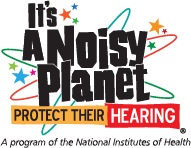In 2008, to raise awareness of the importance of preventing noise-induced hearing loss, the National Institute on Deafness and Other Communication Disorders (NIDCD) initiated the It's a Noisy Planet. Protect Their Hearing® (Noisy Planet) campaign, which targets preteens, parents, and other adults engaged in helping children adopt healthy hearing practices.
Recommended practices for preserving hearing are summarized in the campaign's key message—Turn it Down, Walk Away, or Use Hearing Protection. Noisy Planet maintains a Facebook account (transitioned to an NIDCD-specific account in 2022) to disseminate information. The campaign also distributes copies of more than 20 publications and uses exhibits, sound level meter demonstrations, and interactive presentations to educate preteens and their parents on how sound can damage hearing and how noise-induced hearing loss can be prevented.
The NIDCD wanted to know who was using Noisy Planet resources, whether the campaign was reaching its intended audience, and whether it was achieving its objectives. This information is crucial in making decisions on improving Noisy Planet efforts. In 2012, the NIDCD contracted with NOVA Research Company to conduct an evaluation of the Noisy Planet campaign.
Methods
The evaluation focused on four activities:
- A customer satisfaction survey of people who have ordered materials from the campaign.
- A survey to collect feedback from parents about in-school presentations to their children.
- Interviews with Noisy Planet's partner organizations.
- Analysis of the Noisy Planet website and social media usage.
In addition, the evaluation includes information gathered from focus groups and usability tests for the Noisy Planet website. These complementary efforts were conducted by other contractors.
Selected Findings
Data from the two surveys, web traffic analysis data, and numbers of people involved in NIDCD outreach efforts point to the conclusion that the Noisy Planet is effective in reaching target audiences. Large numbers of parents and other adults have been reached, and most have shared the information they found with preteens. A majority (more than 80 percent) of those who ordered materials said they had used them, and 57 percent had used them specifically to encourage healthy hearing practices in preteens.
Most respondents to the order placer survey were affiliated with educational organizations (including home schoolers). In that survey, 81 percent of respondents were white, 90 percent were female, and most were highly educated. In the parent survey, 70 percent of respondents were white, 86 percent were female, and most were highly educated. These data suggest that NIDCD is reaching a somewhat narrow segment of the target audience; efforts are needed to broaden campaign reach to other target audience segments.
Available data for 2012 on the potential reach of Noisy Planet outreach activities indicate that more than 6 million U.S. citizens may have been reached with Noisy Planet messages through a mix of broadcast media, social media, conferences, material dissemination, and other mechanisms. A snapshot of the reach is shown in the figure below.
| Outreach Type | Reach | Population |
|---|---|---|
| Material distribution |
73,583 |
Parents and other adults |
| School presentations |
2,708 |
preteens |
| Conferences/exhibit attendees |
16,200 |
Nurses/extension agents |
| Newsletter distribution |
2,390 |
Parents/health professionals |
| Unique web visitors |
47,893 |
General public |
| Jeopardy! game show viewers |
5+ million |
U.S. viewing audience |
| Social media |
916,000 |
General public |
| Potential total reach |
6,058,774 |
preteens, parents, public |
Selected Recommendations
Based on the evaluation, several recommendations for improving the Noisy Planet campaign from a variety of perspectives are offered:
- Respondents suggested enabling parents and teachers to order materials in larger quantities. They also expressed interest in promotional tools for encouraging behavior change that are branded with the Noisy Planet logo, such as ear plugs, sound meters, and smartphone applications. Respondents also suggested developing educational materials.
- Improvements to the website suggested by respondents, NOVA experts, and an ICF International (ICFI) usability test report include optimizing the site search engine, making content for preteens more prominent, enhancing access to content through smartphones and tablets, making interactive content easier to find, and increasing connections with social media.
- Partner interviews showed that partnerships are underutilized as a means of leveraging NIDCD's investment in the campaign. Cosponsored webinars and networking events could reinvigorate partnerships. Partners should be able to order materials in bulk. Several partners also reported a high degree of social media engagement, and this could be more effectively leveraged for the Noisy Planet campaign.
- Outreach strategies that could improve the reach of Noisy Planet include expanded promotion of the campaign in disadvantaged communities, links that connect Spanish-language readers directly to translated materials, linkage of campaign activities with Better Speech and Hearing Month, and creation of materials tailored to physician and school health offices. In addition, media outreach should be considered to reach larger numbers of individuals.
- Evaluation staff identified several opportunities for improving collection of data on website use and other campaign activities so that measures of the campaign's success more closely reflect Noisy Planet goals and objectives. Benchmarks should be established for the most important measures, and regular reports should be produced to determine whether goals are being reached.
To order a copy of the full Noisy Planet campaign evaluation report, contact Noisy Planet at 800-241-1044 (voice), 800-241-1055 (TTY), or NPInfo@nidcd.nih.gov.



